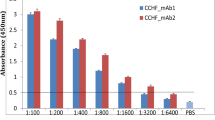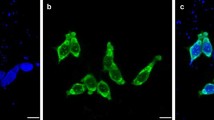Abstract
An immunoaffinity chromatography (IAC) method was optimized for the selective capture of bluetongue virus (BTV) from blood samples and isolation of the virus in cell culture. The antibody against BTV core particles (lacking the outer capsid proteins VP2 and VP5) was used for the optimization of IAC technique. The antibody against BTV core particle was conjugated with Protein A-virus complex and the complex was dissociated using elution buffer (4 M MgCl2 with 75 mM HEPES, pH 6.5). The optimized IAC method specifically purified the BTV without capturing other commonly infecting small ruminant’s viruses like gaotpox virus (GTPV), sheeppox virus (SPPV), Peste des petits ruminants virus (PPRV) and Foot and mouth disease virus (FMDV). The blood samples (n = 22), positive for BTV antigen in sandwich-ELISA were attempted for virus isolation in the BHK-21 cell using the optimized IAC method. A total of seven BTV were isolated by selective capturing of the virion particles. The isolated viruses were characterized by RNA-PAGE, sequence analysis and serum neutralization test (SNT). Electropherotypic analysis of viral dsRNA in the RNA-PAGE revealed the presence of ten dsRNA segments characteristic of BTV. Out of seven isolates, four isolates were identified as BTV-1 and three isolates were identified as BTV-16 based on nucleotide sequences of segment-2. Phylogenetic analysis of segment-2 nucleotide sequence segregated BTV-1 and BTV-16 isolates to monophyletic cluster at close proximity to other eastern topotype. In SNT, hyperimmune serum (HIS) against BTV-1 neutralized the four BTV-1 isolates up to a titer > 256 and HIS against BTV-16 neutralized the three BTV-16 isolates up to a titer > 128. The IAC technique will be useful for the selective capture of BTV from mixed infection (BTV with other small ruminant’s viruses) and isolation from blood sample having low viral load by enrichment.



Similar content being viewed by others
References
MacLachlan NJ (1994) The pathogenesis and immunology of bluetongue virus infection of ruminants. Comp Immunol Microbiol Infect Dis 17:197–206
Howerth EW, Stallknecht DE, Kirkland PD (2001) Bluetongue, epizootic hemorrhagic disease, and other orbivirus-related diseases. In: Williams ES, Barker IK (eds) Infectious diseases of wild mammals, 3rd edn. Iowa State University Press, Iowa, pp 77–97
Mertens PPC, Maan S, Samuel A, Attoui H (2004) Orbivirus, Reoviridae. In: Fauquet CM, Mayo MA, Maniloff J, Dseelberger U, Ball LA (eds) Virus taxonomy, 8th report of the ICTV. Elsevier, London, pp 466–483
Ratinier M, Shaw AE, Barry G, Gu Q, Di Gialleonardo L, Janowicz A, Varela M, Randall RE, Caporale M, Palmarini M (2016) Bluetongue virus NS4 protein is an interferon antagonist and a determinant of virus virulence. J Virol 90:5427–5439
Mellor PS (1990) The replication of bluetongue virus in Culicoides vectors. In: Roy P, Gorman BM (eds) Bluetongue viruses. Springer, Berlin, pp 143–161
Zientara S, Sailleau C, Viarouge C, Höper D, Beer M, Jenckel M, Hoffmann B, Romey A, Bakkali-Kassimi L, Fablet A, Vitour D (2014) Novel bluetongue virus in goats, Corsica, France. Emerg Infect Dis 20:2123e5
Rao PP, Hegde NR, Reddy YN, Krishnajyothi Y, Reddy YV, Susmitha B, Gollapalli SR, Putty K, Reddy GH (2016) Epidemiology of bluetongue in India. Transbound Emerg Dis 63:e151–e164
Clavijo A, Heckert RA, Dulac GC, Afshar A (2000) Isolation and identification of bluetongue virus. J Virol Methods 87:13–23
Saravanan P, Balamurugan V, Sen A, Sarkar J, Sahay B, Rajak KK, Hosamani M, Yadav MP, Singh RK (2007) Mixed infection of peste des petits ruminants and orf on a goat farm in Shahjahanpur, India. Vet Rec 160:410–412
Kul O, Kabakci N, Özkul A, Kalender H, Atmaca HT (2008) Concurrent peste des petits ruminants virus and pestivirus infection in stillborn twin lambs. Vet Pathol 45:191–196
Mondal B, Sen A, Chand K, Biswas SK, De A, Rajak KK, Chakravarti S (2009) Evidence of mixed infection of peste des petits ruminants virus and bluetongue virus in a flock of goats as confirmed by detection of antigen, antibody and nucleic acid of both the viruses. Trop Anim Health Prod 41:1661–1667
Ozmen O, Kale M, Haligur M, Yavru S (2009) Pathological, serological and virological findings in sheep infected simultaneously with bluetongue, peste-des-petits-ruminants and sheeppox viruses. Trop Anim Health Prod 41:951–958
Malik YS, Singh D, Chandrashekar KM, Shukla S, Sharma K, Vaid N, Chakravarti S (2011) Occurrence of dual infection of peste-des-petits-ruminants and goatpox in indigenous goats of Central India. Transbound Emerg Dis 58:268–273
Schwab KJ, De Leon R, Sobsey MD (1996) Immunoaffinity concentration and purification of waterborne enteric viruses for detection by reverse transcriptase PCR. Appl Environ Microb 62:2086–2094
Chand K, Biswas SK, Mondal B (2016) Purification of infective bluetongue virus particles by immuno-affinity chromatography using anti-core antibody. Virus Dis 27:98–101
Chand K, Biswas SK, De A, Sing B, Mondal B (2009) A polyclonal antibody-based sandwich ELISA for the detection of bluetongue virus in cell culture and blood of sheep infected experimentally. J Virol Methods 160:189–192
Dangler CA, De Mattos CA, De Mattos CC, Osburn BI (1990) Identifying bluetongue virus ribonucleic acid sequence by polymerase chain reaction. J Virol Method 28:281–292
Attoui H, Billoir F, Cantaloube JF, Biagini P, de Micco P, de Lamballerie X (2000) Stratigies for sequence determination of viral dsRNA genomes. J Virol Methods 89:147–158
Squire KRE, Chuang RY, Osburn BI, Knudson DL, Doi RH (1983) Rapid methods for comparing the double-stranded RNA genome profiles of bluetongue virus. Vet Microbiol 8:543–553
Promega Protocols (1996) Silver staining the sequencing gel. Protocols and applications guide, 3rd edn. Promega Corporation, Madison, pp 157–158
Hofmann MA, Renzullo S, Mader M, Chaignat V, Worwa G, Thuer B (2008) Genetic characterization of Toggenburg orbivirus a new bluetongue virus from goats Switzerland. Emerg Infect Dis 12:1855–1861
Tamura K, Stecher G, Peterson D, Filipski A, Kumar S (2013) MEGA6: molecular evolutionary genetics analysis version 6.0. Mol Biol Evol 30:2725–2729
Maan S, Maan NS, Van Rijn PA, Van Gennip RG, Sanders A, Wright IM, Batten C, Hoffmann B, Eschbaumer M, Oura CA, Potgieter AC (2010) Full genome characterization of bluetongue virus serotype 6 from the Netherlands 2008 and comparison to other field and vaccine strains. PLoS ONE 5:e10323
MacLachlan NJ, Rossitto PV, Heidner HW, Iezzi LG, Yilma TD, DeMaula CD, Osburn BI (1992) Variation amongst the neutralizing epitopes of bluetongue viruses isolated in the United States in 1979–1981. Vet Microbiol 31:303–316
Sugiura TA, Nakajima HI (1977) Purification of equine infectious anemia virus antigen by affinity chromatography. J Clin Microbiol 5:635–639
Pele C, Gillam S (1985) Purification of biologically active rubella virus antigens by immunoaffinity chromatography. J Virol Methods 10:261–268
Rimmelzwaan GF, Groen J, Juntti N, Teppema JS, UytdeHaag FG, Osterhaus AD (1987) Purification of infectious canine parvovirus from cell culture by affinity chromatography with monoclonal antibodies. J Virol Methods 15:313–322
Zhen S, Changyuan D, Lulu W, Dong-E C, Guoming B, Ming D, Jun L (2010) A novel method for purifying bluetongue virus with high purity by co-immunoprecipitation with agarose protein-A. Virol J 7:126
Pedley S, Mohamed ME, Mertens PP (1988) Analysis of genome segments from six different isolates of bluetongue virus using RNA-RNA hybridisation: a generalised coding assignment for bluetongue viruses. Virus Res 10:381–390
Pritchard LI, Gould AR (1995) Phylogenetic comparison of the serotype-specific VP2 protein of bluetongue and related orbiviruses. Virus Res 39:207–220
Maan S, Maan NS, Belaganahalli MN, Rao PP, Singh KP, Hemadri D, Putty K, Kumar A, Batra K, Krishnajyothi Y, Chandel BS (2015) Full-genome sequencing as a basis for molecular epidemiology studies of bluetongue virus in India. PLoS ONE 10:e0131257
Shafiq M, Minakshi P, Bhateja A, Ranjan K, Prasad G (2013) Evidence of genetic reassortment between Indian isolate of bluetongue virus serotype 21 (BTV-21) and bluetongue virus serotype 16 (BTV-16). Virus Res 173:336–343
Maan S, Ghosh A, Batra K, Kumar A, Maan NS (2013) Genomic diversity among eastern and western topotypes of bluetongue virus serotype 16 based on whole genome sequence analysis. Vet World 6:960–962
Fukusho A, Ritter GD, Roy P (1987) Variation in the bluetongue virus neutralization protein VP2. J Gen Virol 68:2967–2973
Mertens PP, Pedley S, Cowley J, Burroughs JN, Corteyn AH, Jeggo MH, Jennings DM, Gorman BM (1989) Analysis of the role of bluetongue virus outer capsid proteins VP2 and VP5 in determination of virus serotype. Virology 170:561–565
Acknowledgements
This work has been supported by an ICAR (No. F.13 (1)/2000-ASRIV) project—All India Network Programme on Bluetongue. The authors wish to thank the Director ICAR-IVRI; Head, Division of Virology and the Coordinator, AINP-BT project for providing the facilities.
Author information
Authors and Affiliations
Corresponding author
Ethics declarations
Conflict of interest
The authors declare that they have no conflict of interest.
Rights and permissions
About this article
Cite this article
Chand, K., Biswas, S.K. & Mondal, B. Isolation and Characterization of Bluetongue Virus Recovered from Blood Samples by Immunoaffinity Purification. Indian J Microbiol 58, 433–439 (2018). https://doi.org/10.1007/s12088-018-0735-z
Received:
Accepted:
Published:
Issue Date:
DOI: https://doi.org/10.1007/s12088-018-0735-z




